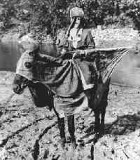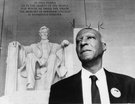Between Civil War and Civil Rights |
|
formerly 
|
|
|
This ongoing series explores roots of and remedies for what may be America's most powerful and lasting predicament: the racial divide resulting in part from the longest, bloodiest, most successful campaign of domestic terrorism and propaganda in U.S. history. It highlights the historic (and heroic) role of minorities in fighting for democratic values and justice nationwide.
|
|
|
|
|
|
|
|
|
|
|
|

An early photograph of a White Supremacist vigilante.
|
|
1865—1876
How the South (or White Supremacy) Won the War
From the founding of the Ku Klux Klan by ex-Confederate officers, to the end of the Reconstruction.
Find out more
|
|
|
|
|
|
|
|
|
|

A distorted and misleading image, from Collier's Weekly magazine of November 26 1898, typical of the press at the time.
|
|
1898—
Democracy's Denial: Revolutions in Wilmington
The story of the only coup d’etat in U.S. history, in 1898 in Wilmington, NC, and its continuing effect on that community and the nation.
Find out more
Listening Between the Lines and Wilmington’s public/community radio station hosted two public forum discussions.
Find out more
|
|
|
|
|
|
|
|
|
|
|
|

From a Klan-made movie
|
|
1915—1925
White Protestant Nation
From Birth of a Nation to the rebirth—and fall—of the Ku Klux Klan as a mass fraternal organization.
Find out more
|
|
|
|
|
|
|
|
|
|
|
|

Rosewood survivor Minnie Lee Langley (photo by Charles Flowers)
|
|
1923—
Rosewood Reborn
The infamous 7-day ruin of Rosewood, Florida in 1923, and its aftermath, including the only payment of reparations for mass racial violence by a U.S. government.
Find out more
|
|
|
|
|
|
|
|
|
|
|
|

Pullman-car porters’ union-leader A Philip Randolph, and another racial “radical”
|
|
1940—1954
American as Apple Pie:
When Terror Lost in America
Nationally broadcast during Black History Month, 2003, American as Apple Pie tells the story of the organizing drives and campaigns of the 1940s and early 1950s.
|
|
|
|
|